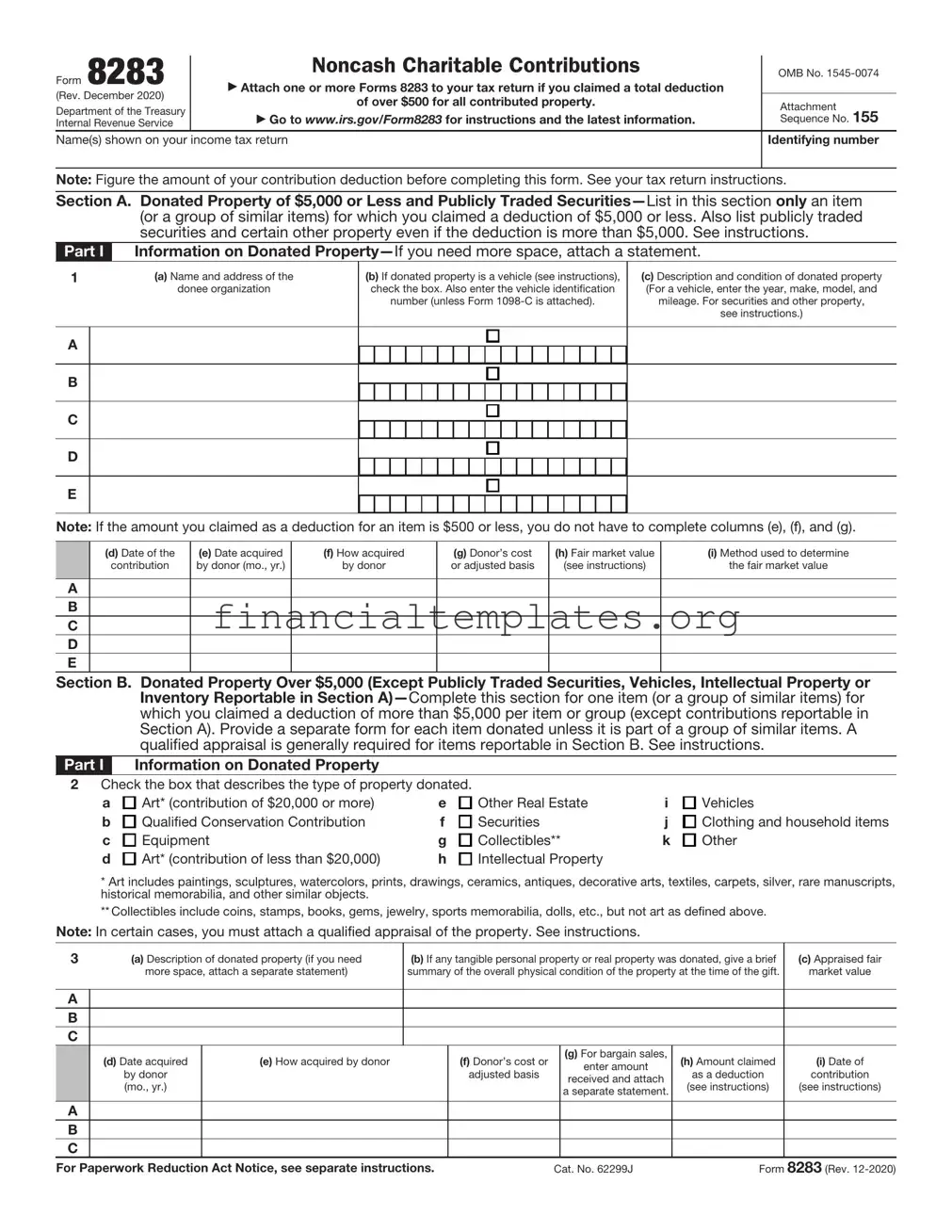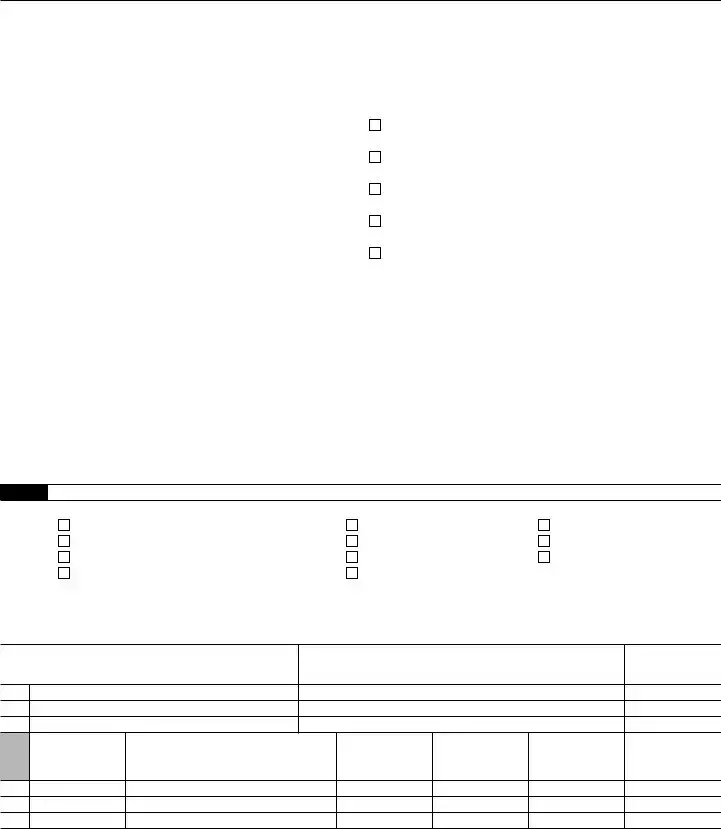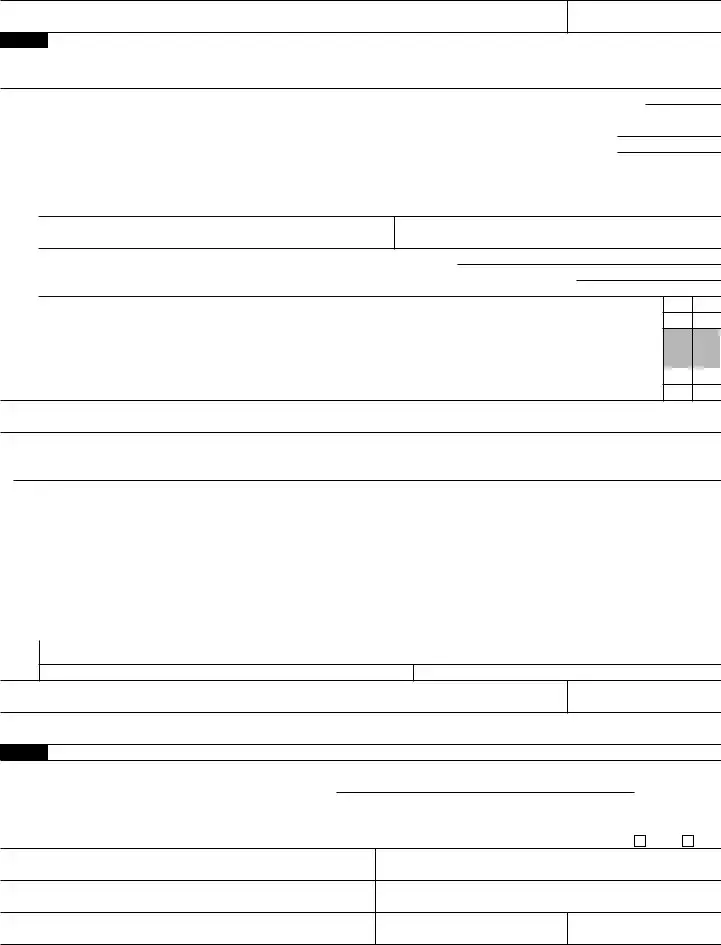Form 8283 |
|
Noncash Charitable Contributions |
|
OMB No. 1545-0074 |
|
|
|
▶ Attach one or more Forms 8283 to your tax return if you claimed a total deduction |
|
|
(Rev. December 2021) |
|
of over $500 for all contributed property. |
|
Attachment |
Department of the Treasury |
|
|
|
|
|
|
▶ Go to www.irs.gov/Form8283 for instructions and the latest information. |
|
Sequence No. 155 |
Internal Revenue Service |
|
|
Name(s) shown on your income tax return |
|
Identifying number |
|
|
|
|
|
Note: Figure the amount of your contribution deduction before completing this form. See your tax return instructions.
Section A. Donated Property of $5,000 or Less and Publicly Traded Securities—List in this section only an item (or a group of similar items) for which you claimed a deduction of $5,000 or less. Also list publicly traded securities and certain other property even if the deduction is more than $5,000. See instructions.
Part I |
Information on Donated Property—If you need more space, attach a statement. |
1 |
|
(a) Name and address of the |
(b) If donated property is a vehicle (see instructions), |
(c) Description and condition of donated property |
|
|
donee organization |
check the box. Also enter the vehicle identification |
(For a vehicle, enter the year, make, model, and |
|
|
|
|
|
number (unless Form 1098-C is attached). |
mileage. For securities and other property, |
|
|
|
|
|
|
|
|
|
|
|
|
|
|
|
|
|
|
|
|
see instructions.) |
|
|
|
|
|
|
|
|
|
|
|
|
|
|
|
|
|
|
|
|
|
A |
|
|
|
|
|
|
|
|
|
|
|
|
|
|
|
|
|
|
|
|
|
|
|
|
|
|
|
|
|
|
|
|
|
|
|
|
|
|
|
|
|
|
|
|
|
|
|
|
|
|
|
|
|
|
|
|
|
|
|
|
|
B |
|
|
|
|
|
|
|
|
|
|
|
|
|
|
|
|
|
|
|
|
|
|
|
|
|
|
|
|
|
|
|
|
|
|
|
|
|
|
|
|
|
|
|
|
|
|
|
|
|
|
|
|
|
|
|
|
|
|
|
|
|
C |
|
|
|
|
|
|
|
|
|
|
|
|
|
|
|
|
|
|
|
|
|
|
|
|
|
|
|
|
|
|
|
|
|
|
|
|
|
|
|
|
|
|
|
|
|
|
|
|
|
|
|
|
|
|
|
|
|
|
|
|
|
D |
|
|
|
|
|
|
|
|
|
|
|
|
|
|
|
|
|
|
|
|
|
|
|
|
|
|
|
|
|
|
|
|
|
|
|
|
|
|
|
|
|
|
|
|
|
|
|
|
|
|
|
|
|
|
|
|
|
|
|
|
|
E |
|
|
|
|
|
|
|
|
|
|
|
|
|
|
|
|
|
|
|
|
|
|
|
|
|
|
|
|
|
|
|
|
|
|
|
|
|
|
|
|
|
|
|
|
|
|
|
|
|
|
|
|
|
|
|
|
|
|
|
|
|
Note: If the amount you claimed as a deduction for an item is $500 or less, you do not have to complete columns (e), (f), and (g).
|
(d) Date of the |
(e) Date acquired |
(f) How acquired |
(g) Donor’s cost |
(h) Fair market value |
(i) Method used to determine |
|
contribution |
by donor (mo., yr.) |
by donor |
or adjusted basis |
(see instructions) |
the fair market value |
|
|
|
|
|
|
|
A |
|
|
|
|
|
|
B |
|
|
|
|
|
|
C |
|
|
|
|
|
|
D |
|
|
|
|
|
|
E |
|
|
|
|
|
|
Section B. Donated Property Over $5,000 (Except Publicly Traded Securities, Vehicles, Intellectual Property or Inventory Reportable in Section A)—Complete this section for one item (or a group of similar items) for which you claimed a deduction of more than $5,000 per item or group (except contributions reportable in Section A). Provide a separate form for each item donated unless it is part of a group of similar items. A qualified appraisal is generally required for items reportable in Section B. See instructions.
Part I Information on Donated Property
2Check the box that describes the type of property donated.
a |
Art* (contribution of $20,000 or more) |
e |
Other Real Estate |
i |
Vehicles |
b |
Qualified Conservation Contribution |
f |
Securities |
j |
Clothing and household items |
c |
Equipment |
g |
Collectibles** |
k |
Other |
d |
Art* (contribution of less than $20,000) |
h |
Intellectual Property |
|
|
*Art includes paintings, sculptures, watercolors, prints, drawings, ceramics, antiques, decorative arts, textiles, carpets, silver, rare manuscripts, historical memorabilia, and other similar objects.
**Collectibles include coins, stamps, books, gems, jewelry, sports memorabilia, dolls, etc., but not art as defined above.
Note: In certain cases, you must attach a qualified appraisal of the property. See instructions.
3 |
(a) Description of donated property (if you need |
(b) If any tangible personal property or real property was donated, give a brief |
(c) Appraised fair |
|
more space, attach a separate statement) |
summary of the overall physical condition of the property at the time of the gift. |
market value |
|
|
|
|
|
|
|
|
|
A |
|
|
|
|
|
|
|
|
B |
|
|
|
|
|
|
|
|
C |
|
|
|
|
|
|
|
|
|
(d) Date acquired |
(e) How acquired by donor |
|
(f) Donor’s cost or |
|
(g) For bargain sales, |
(h) Amount claimed |
(i) Date of |
|
by donor |
|
|
adjusted basis |
|
enter amount |
as a deduction |
contribution |
|
(mo., yr.) |
|
|
|
|
received |
(see instructions) |
(see instructions) |
|
|
|
|
|
|
|
|
|
A |
|
|
|
|
|
|
|
|
B |
|
|
|
|
|
|
|
|
C |
|
|
|
|
|
|
|
|
For Paperwork Reduction Act Notice, see separate instructions. |
Cat. No. 62299J |
Form |
8283 (Rev. 12-2021) |
Form 8283 (Rev. 12-2021) |
Page 2 |
Name(s) shown on your income tax return |
Identifying number |
Part II Partial Interests and Restricted Use Property (Other Than Qualified Conservation Contributions)— Complete lines 4a through 4e if you gave less than an entire interest in a property listed in Section B, Part I. Complete lines 5a through 5c if conditions were placed on a contribution listed in Section B, Part I; also attach the required statement. See instructions.
4a Enter the letter from Section B, Part I that identifies the property for which you gave less than an entire interest ▶ If Section B, Part II applies to more than one property, attach a separate statement.
b Total amount claimed as a deduction for the property listed in Section B, Part I: (1) |
For this tax year . . ▶ |
(2) |
For any prior tax years ▶ |
cName and address of each organization to which any such contribution was made in a prior year (complete only if different from the donee organization in Section B, Part V, below):
Name of charitable organization (donee)
Address (number, street, and room or suite no.) |
City or town, state, and ZIP code |
|
|
dFor tangible property, enter the place where the property is located or kept ▶
eName of any person, other than the donee organization, having actual possession of the property ▶
Yes No
5a Is there a restriction, either temporary or permanent, on the donee’s right to use or dispose of the donated property?
bDid you give to anyone (other than the donee organization or another organization participating with the donee
organization in cooperative fundraising) the right to the income from the donated property or to the possession of the property, including the right to vote donated securities, to acquire the property by purchase or otherwise, or to designate the person having such income, possession, or right to acquire? . . . . . . . . . . . . .
cIs there a restriction limiting the donated property for a particular use? . . . . . . . . . . . . . .
Part III Taxpayer (Donor) Statement—List each item included in Section B, Part I above that the appraisal identifies as having a value of $500 or less. See instructions.
I declare that the following item(s) included in Section B, Part I above has to the best of my knowledge and belief an appraised value of not more than $500 (per item). Enter identifying letter from Section B, Part I and describe the specific item. See instructions.
▶
Signature of |
|
|
taxpayer (donor) ▶ |
Date ▶ |
Part IV |
|
Declaration of Appraiser |
|
I declare that I am not the donor, the donee, a party to the transaction in which the donor acquired the property, employed by, or related to any of the foregoing persons, or married to any person who is related to any of the foregoing persons. And, if regularly used by the donor, donee, or party to the transaction, I performed the majority of my appraisals during my tax year for other persons.
Also, I declare that I perform appraisals on a regular basis; and that because of my qualifications as described in the appraisal, I am qualified to make appraisals of the type of property being valued. I certify that the appraisal fees were not based on a percentage of the appraised property value. Furthermore, I understand that a false or fraudulent overstatement of the property value as described in the qualified appraisal or this Form 8283 may subject me to the penalty under section 6701(a) (aiding and abetting the understatement of tax liability). I understand that my appraisal will be used in connection with a return or claim for refund. I also understand that, if there is a substantial or gross valuation misstatement of the value of the property claimed on the return or claim for refund that is based on my appraisal, I may be subject to a penalty under section 6695A of the Internal Revenue Code, as well as other applicable penalties. I affirm that I have not been at any time in the three-year period ending on the date of the appraisal barred from presenting evidence or testimony before the Department of the Treasury or the Internal Revenue Service pursuant to 31 U.S.C. 330(c).
Sign |
Appraiser signature ▶ |
|
Date ▶ |
Here |
|
Appraiser name ▶ |
Title ▶ |
Business address (including room or suite no.) |
|
Identifying number |
|
|
|
|
City or town, state, and ZIP code
Part V Donee Acknowledgment
This charitable organization acknowledges that it is a qualified organization under section 170(c) and that it received the donated property as described in Section B, Part I, above on the following date ▶
Furthermore, this organization affirms that in the event it sells, exchanges, or otherwise disposes of the property described in Section B, Part I (or any portion thereof) within 3 years after the date of receipt, it will file Form 8282, Donee Information Return, with the IRS and give the donor a copy of that form. This acknowledgment does not represent agreement with the claimed fair market value.
Does the organization intend to use the property for an unrelated use? |
. . . . . . . . . . . |
. . . ▶ |
Yes |
No |
Name of charitable organization (donee) |
Employer identification number |
|
|
|
|
|
|
|
|
Address (number, street, and room or suite no.) |
City or town, state, and ZIP code |
|
|
|
|
|
|
|
|
Authorized signature |
Title |
Date |
|
|
Form 8283 (Rev. 12-2021)


